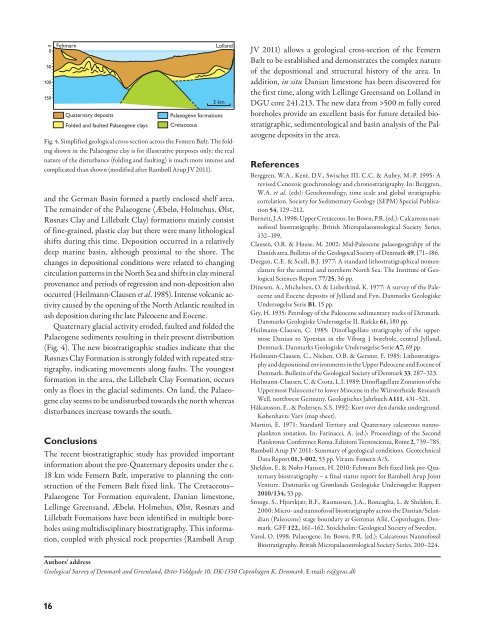Geological Survey of Denmark and Greenland Bulletin 26 ... - Geus
Geological Survey of Denmark and Greenland Bulletin 26 ... - Geus
Geological Survey of Denmark and Greenland Bulletin 26 ... - Geus
Create successful ePaper yourself
Turn your PDF publications into a flip-book with our unique Google optimized e-Paper software.
m<br />
0<br />
50<br />
100<br />
150<br />
Fehmarn<br />
Quaternary deposits<br />
Folded <strong>and</strong> faulted Palaeogene clays<br />
Loll<strong>and</strong><br />
3 km<br />
Palaeogene formations<br />
Cretaceous<br />
Fig. 4. Simplified geological cross-section across the Femern Bælt. The folding<br />
shown in the Palaeogene clay is for illustrative purposes only; the real<br />
nature <strong>of</strong> the disturbance (folding <strong>and</strong> faulting) is much more intense <strong>and</strong><br />
complicated than shown (modified after Rambøll Arup JV 2011).<br />
<strong>and</strong> the German Basin formed a partly enclosed shelf area.<br />
The remainder <strong>of</strong> the Palaeogene (Æbelø, Holmehus, Ølst,<br />
Røsnæs Clay <strong>and</strong> Lillebælt Clay) formations mainly consist<br />
<strong>of</strong> fine-grained, plastic clay but there were many lithological<br />
shifts during this time. Deposition occurred in a relatively<br />
deep marine basin, although proximal to the shore. The<br />
changes in depositional conditions were related to changing<br />
circulation patterns in the North Sea <strong>and</strong> shifts in clay mineral<br />
provenance <strong>and</strong> periods <strong>of</strong> regression <strong>and</strong> non-deposition also<br />
occurred (Heilmann-Clausen et al. 1985). Intense volcanic activity<br />
caused by the opening <strong>of</strong> the North Atlantic resulted in<br />
ash deposition during the late Paleocene <strong>and</strong> Eocene.<br />
Quaternary glacial activity eroded, faulted <strong>and</strong> folded the<br />
Palaeogene sediments resulting in their present distribution<br />
(Fig. 4). The new biostratigraphic studies indicate that the<br />
Røsnæs Clay Formation is strongly folded with repeated stratigraphy,<br />
indicating movements along faults. The youngest<br />
formation in the area, the Lillebælt Clay Formation, occurs<br />
only as floes in the glacial sediments. On l<strong>and</strong>, the Palaeogene<br />
clay seems to be undisturbed towards the north whereas<br />
disturbances increase towards the south.<br />
Conclusions<br />
The recent biostratigraphic study has provided important<br />
information about the pre-Quaternary deposits under the c.<br />
18 km wide Femern Bælt, imperative to planning the construction<br />
<strong>of</strong> the Femern Bælt fixed link. The Cretaceous–<br />
Palaeogene Tor Formation equivalent, Danian limestone,<br />
Lellinge Greens<strong>and</strong>, Æbelø, Holmehus, Ølst, Røsnæs <strong>and</strong><br />
Lillebælt Formations have been identified in multiple boreholes<br />
using multidisciplinary biostratigraphy. This information,<br />
coupled with physical rock properties (Rambøll Arup<br />
JV 2011) allows a geological cross-section <strong>of</strong> the Femern<br />
Bælt to be established <strong>and</strong> demonstrates the complex nature<br />
<strong>of</strong> the depositional <strong>and</strong> structural history <strong>of</strong> the area. In<br />
addition, in situ Danian limestone has been discovered for<br />
the first time, along with Lellinge Greens<strong>and</strong> on Loll<strong>and</strong> in<br />
DGU core 241.213. The new data from >500 m fully cored<br />
boreholes provide an excellent basis for future detailed biostratigraphic,<br />
sedimentological <strong>and</strong> basin analysis <strong>of</strong> the Palaeogene<br />
deposits in the area.<br />
References<br />
Berggren, W.A., Kent, D.V., Swischer III, C.C. & Aubry, M.-P. 1995: A<br />
revised Cenozoic geochronology <strong>and</strong> chronostratigraphy. In: Berggren,<br />
W.A. et al. (eds): Geochronology, time scale <strong>and</strong> global stratigraphic<br />
correlation. Society for Sedimentary Geology (SEPM) Special Publication<br />
54, 129–212.<br />
Burnett, J.A. 1998: Upper Cretaceous. In: Bown, P.R. (ed.): Calcareous nann<strong>of</strong>ossil<br />
biostratigraphy. British Micropalaeontological Society Series,<br />
132–199.<br />
Clausen, O.R. & Huuse, M. 2002: Mid-Paleocene palaeogeograhpy <strong>of</strong> the<br />
Danish area. <strong>Bulletin</strong> <strong>of</strong> the Geologocal Society <strong>of</strong> <strong>Denmark</strong> 49, 171–186.<br />
Deegan, C.E. & Scull, B.J. 1977: A st<strong>and</strong>ard lithostratigraphical nomenclature<br />
for the central <strong>and</strong> northern North Sea. The Institute <strong>of</strong> <strong>Geological</strong><br />
Sciences Report 77/25, 36 pp.<br />
Dinesen, A., Michelsen, O. & Lieberkind, K. 1977: A survey <strong>of</strong> the Paleocene<br />
<strong>and</strong> Eocene deposits <strong>of</strong> Jyll<strong>and</strong> <strong>and</strong> Fyn. Danmarks Geologiske<br />
Undersøgelse Serie B1, 15 pp.<br />
Gry, H. 1935: Petrology <strong>of</strong> the Paleocene sedimentary rocks <strong>of</strong> <strong>Denmark</strong>.<br />
Danmarks Geologiske Undersøgelse II. Række 61, 180 pp.<br />
Heilmann-Clausen, C. 1985: Din<strong>of</strong>lagellate stratigraphy <strong>of</strong> the uppermost<br />
Danian to Ypresian in the Viborg 1 borehole, central Jyll<strong>and</strong>,<br />
<strong>Denmark</strong>. Danmarks Geologiske Undersøgelse Serie A7, 69 pp.<br />
Heilmann-Clausen, C., Nielsen, O.B. & Gersner, F. 1985: Lithostratigraphy<br />
<strong>and</strong> depositional environments in the Upper Paleocene <strong>and</strong> Eocene <strong>of</strong><br />
<strong>Denmark</strong>. <strong>Bulletin</strong> <strong>of</strong> the <strong>Geological</strong> Society <strong>of</strong> <strong>Denmark</strong> 33, 287–323.<br />
Heilmann-Clausen, C. & Costa, L.I. 1989: Din<strong>of</strong>lagellate Zonation <strong>of</strong> the<br />
Uppermost Paleocene? to lower Miocene in the Würsterheide Research<br />
Well, northwest Germany. Geologisches Jahrbuch A111, 431–521.<br />
Håkansson, E., & Pedersen, S.S. 1992: Kort over den danske undergrund.<br />
København: Varv (map sheet).<br />
Martini, E. 1971: St<strong>and</strong>ard Tertiary <strong>and</strong> Quaternary calcareous nannoplankton<br />
zonation. In: Farinacci, A. (ed.): Proceedings <strong>of</strong> the Second<br />
Planktonic Conference Roma. Edizioni Tecnoscienza, Rome 2, 739–785.<br />
Rambøll Arup JV 2011: Summary <strong>of</strong> geological conditions. Geotechnical<br />
Data Report 01.3-002, 53 pp. Virum: Femern A/S.<br />
Sheldon, E. & Nøhr-Hansen, H. 2010: Fehmarn Belt fixed link pre-Quaternary<br />
biostratigraphy – a final status report for Rambøll Arup Joint<br />
Venture. Danmarks og Grønl<strong>and</strong>s Geologiske Undersøgelse Rapport<br />
2010/134, 53 pp.<br />
Stouge, S., Hjortkjær, B.F., Rasmussen, J.A., Roncaglia, L. & Sheldon, E.<br />
2000: Micro- <strong>and</strong> nann<strong>of</strong>ossil biostratigraphy across the Danian/Sel<strong>and</strong>ian<br />
(Paleocene) stage boundary at Gemmas Allé, Copenhagen, <strong>Denmark</strong>.<br />
GFF 122, 161–162. Stockholm: <strong>Geological</strong> Society <strong>of</strong> Sweden.<br />
Varol, O. 1998: Palaeogene. In: Bown, P.R. (ed.): Calcareous Nann<strong>of</strong>ossil<br />
Biostratigraphy. British Micropalaeontological Society Series, 200–224.<br />
Authors’ address<br />
<strong>Geological</strong> <strong>Survey</strong> <strong>of</strong> <strong>Denmark</strong> <strong>and</strong> Greenl<strong>and</strong>, Øster Voldgade 10, DK-1350 Copenhagen K, <strong>Denmark</strong>. E-mail: es@geus.dk<br />
16

















